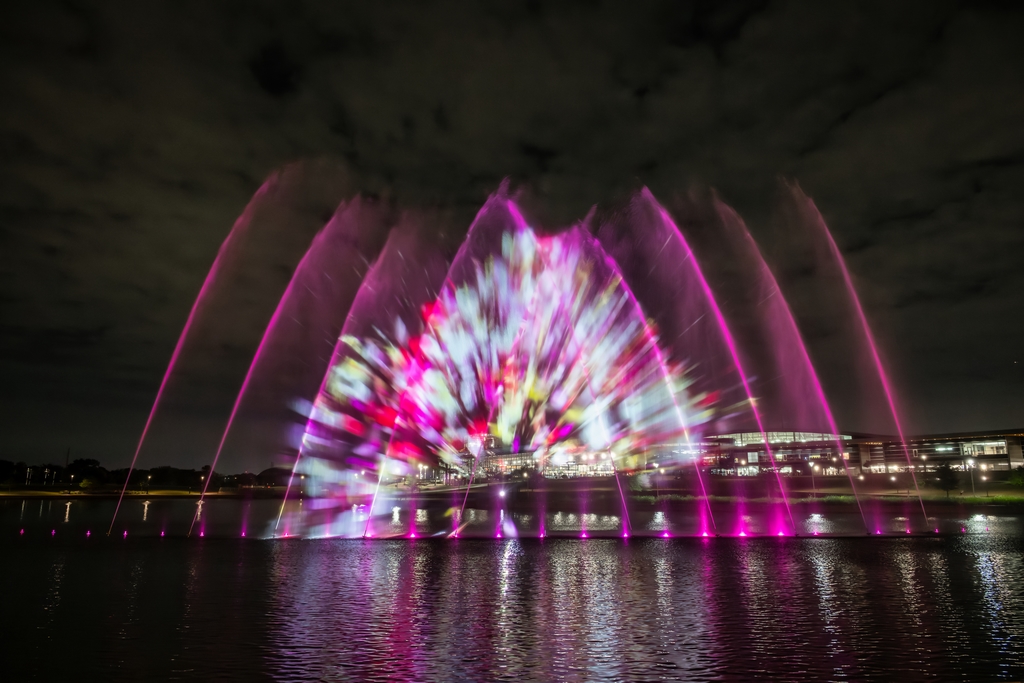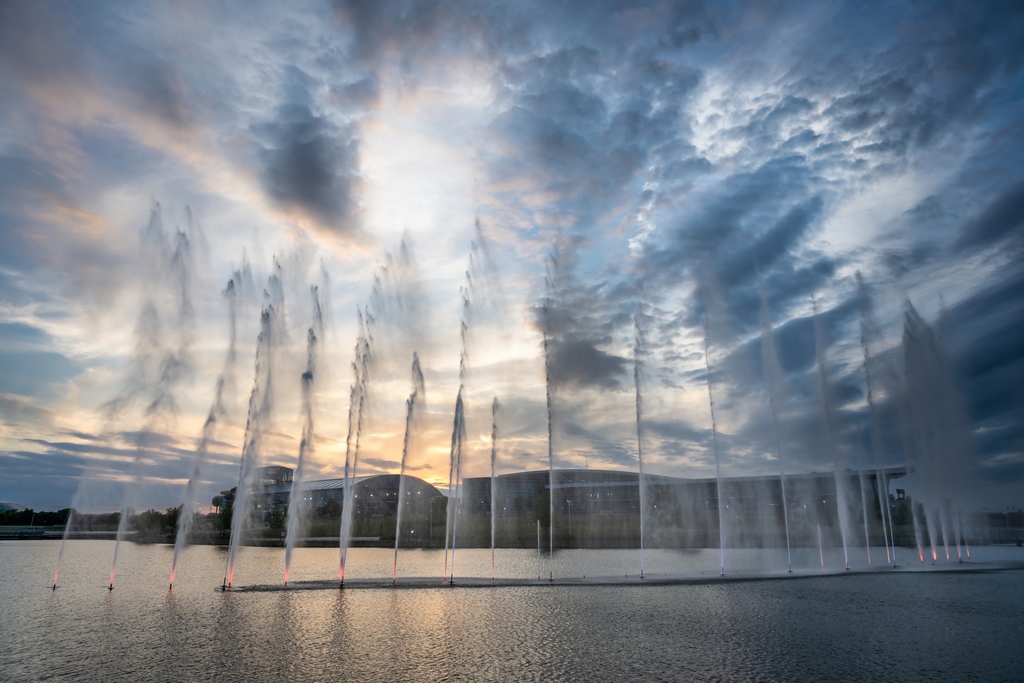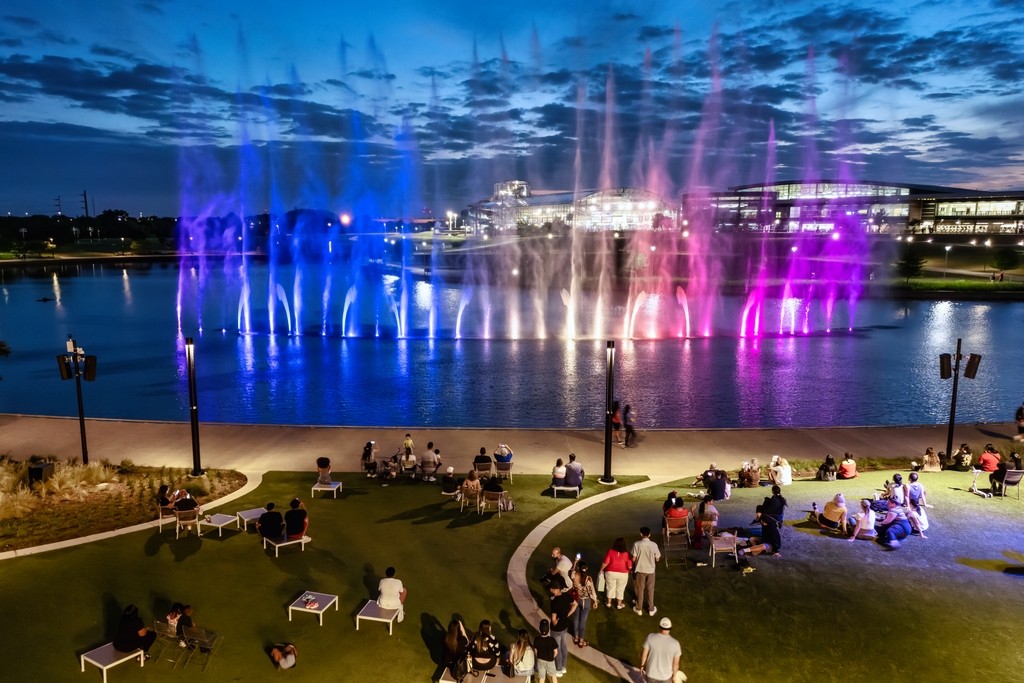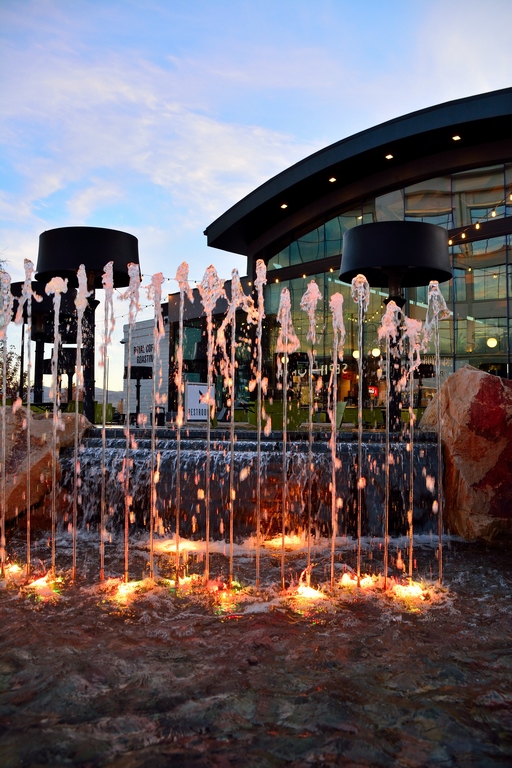AI Drives Show-Fountain Experiences


Artificial Intelligence (AI-driven displays are drawing thousands of visitors each week to venues with show fountains, reports J. Wickham “Wick” Zimmerman of Outside The Lines, Inc. OTL is a waterfeature design/build and maintenance firm that has installed its own patented AI technology into two high-profile fountains that are capable of responding to and learning from fountain spectators.
By J. Wickham Zimmerman
Consumers have always been attracted to show fountains’ dazzling displays, featuring artfully choreographed water jets accented by colors, lights, music and other effects.
Over the last few years, however, artificial intelligence has enabled us to create next-level experiences around water features that are more engaging than ever. We’ve found that applying this technology to fountains can dramatically elevate foot traffic, increasing the length of stay and dollars spent at the sites where these water features are installed. The result is a boost in revenue that benefits owners, their tenants, and a host of other stakeholders.
This year, our team at OTL has been hard at work deploying a new AI technology we developed called Aquarius Interactive. Our goal was to add value to water features by increasing guest engagement—without having to get wet. With AI applications taking off in nearly every aspect of society, improving efficiency and convenience for everyone involved, we knew that this technology would enable us to bring next-level experiences to our water features and add value to the commercial properties where these projects are located.
THE TEAM AND THE TECHNOLOGY
Aquarius Interactive was developed and patented by our team of highly skilled artisans, engineers and business professionals. This proprietary technology allows water features to interact directly with guests, capturing their movements through cameras and then translating that into the movement of the fountain’s water and lights to create a unique experience at each interaction.
Before we created Aquarius Interactive, the concept of interactive water features was not new—but providing fountain interactivity without the need for a handheld device, or pressure pads while guests remain completely dry, was (and still is) revolutionary.
As we designed the user experience, software engineer Matt Leebert offered a unique perspective, and he helped us realize that artificial intelligence was the right solution for the effect we wanted to achieve. AI can synthesize large amounts of data and analyze it quickly, including visual data that can be captured by cameras near the fountain. It can then categorize this data by location, height, and other factors and direct the nozzles, lights, and other effects to mimic guests’ movements.
Once we had developed Aquarius Interactive, we then tested the technology in our studio before implementing it at any of the water features we had built, or were in the process of constructing. This allowed us to tweak the technology in-house before deploying it at real water features.
The truly magical part of this technology is that it interacts with the crowd without requiring additional hardware such as wands or touchpads. The system is guided by the guests’ motions, and it connotes a sense of wonder that enthralls people of every age. In fact, guests and participants may not even be aware that the technology is installed until the fountain begins to interact with them.
As we were in the process of developing and testing the new AI software, we identified its ability to bring value to water features in retail/entertainment settings, where dwell times, and therefore dollars spent, could be increased with its inclusion.
To date, we have deployed it in two large fountains in the U.S.: one at EpicCentral, a 172-acre entertainment district in Grand Prairie, TX; and one at Mountain View Village, an 85-acre mixed-use development in Riverton, UT that offers retail, dining, and entertainment. Since Aquarius Interactive was installed, the excitement around these two water features is palpable; and, it’s based on the unforgettable experience this technology creates for visitors
AQUARIUS INTERACTIVE MEETS ILLUVIA
In 2022, our team was asked to design and construct a show fountain at EpicCentral, a site that already contained five lakes and was planned to house an entertainment district featuring restaurants, theme parks and hotels. We developed the concept for a show fountain at the largest lake at EpicCentral called “Illuvia”, featuring large-scale projection, specialty lighting effects, and music on four acres of water.
The fountain was designed with thrilling air-fired jets and robotic nozzles that propel water to heights of over 60 feet, creating a statement that is visible from all around.
At the beginning of the design phase, we did not envision incorporating an AI system into the fountain. In fact, after we designed and constructed Illuvia, the feature attracted visitors from near and far to watch its programmed displays – which were awe-inspiring even without artificial intelligence.
Around that time, however, our team was also developing and patenting Aquarius Interactive. Once it was ready for prime time, we began to envision incorporating this technology into Illuvia.
Our team had to overcome several challenges to successfully complete the process of transforming Illuvia into an AI-enabled fountain. We identified some issues with Illuvia that made installing the technology with a single-camera system inadequate. There were several obstacles close to the fountain that could obscure a single camera’s ability to adequately capture motion.
Additionally, the walkway area in front of the fountain, and the water feature itself, were both very large, and the walkway area was curved. Lastly, the sizeable lake meant we needed more cameras than anticipated. The use of more than one camera for all these reasons meant we had to adjust the Aquarius Interactive system to allow for more inputs.
In addition, we realized we needed to use IP cameras due to the distance from the cameras to the equipment room. This onsite, air-conditioned special equipment room already housed the server and the control system for the fountain, so we added the AI computer equipment and rack to the same space.
Once we overcame these challenges, and Aquarius Interactive was installed and launched at Illuvia, our team had to adjust the cameras to capture motion properly. We streamlined this process by watching guests’ interaction from the nearby control room and made modifications to the camera positions as needed for the desired result.
In the end, implementing our innovative AI technology at Illuvia, EpicCentral’s crown jewel, added significant value to the property that can be leveraged for years to come. Now, the property’s owners note that patrons didn’t mind the longer wait times at the surrounding restaurants, and time spent on site increased from 60 minutes up to as much as 120 minutes.
Thanks to AI’s machine-learning aspect, the technology will continue to improve over time, providing increasingly more breathtaking effects to dazzle guests and keep them returning to the park again and again.
A NEXT PHASE
Our team had previously designed and constructed an architectural fountain for Phase I of CenterCal Properties’ 85-acre lifestyle development Mountain View Village in Riverton, Utah. We were then asked to design and engineer a new show fountain for Phase II of the site, which broke ground in 2019. The shopping center and community gathering place features a movie theater, restaurants, and almost 100 retail tenants, as well as landscaped parks and parklets.
Completing this second water feature at the center presented some challenges. The fountain was uniquely designed to include a curved infinity edge on the backside with a waterfall that required natural stone from the area to match the existing design and budget. After an extensive search, our team selected natural stone from a local supplier, a sustainable practice that is imperative when sourcing heavy materials like stone.
Cuts to the initial budget presented concerns as we had to reduce the number of pumps we had planned to use; but, we were unable to cut the number of nozzles included in the design without limiting the fountain’s display capabilities. To solve this issue, we created a custom-made manifold that accommodated the new ratio and aligned the nozzles properly.
Even though the second Mountain View Village water feature was much smaller in size than Illuvia, we utilized the lessons we had learned from Illuvia regarding adequate camera coverage when incorporating Aquarius Interactive technology into the Mountain View Village show fountain. We ensured the high-quality cameras our team installed covered all angles of the fountain and were able to use part of a basement room next to the fountain for equipment needed for the AI technology.
As Aquarius Interactive evolved, we worked more on refining this technology to become almost intuitive, teaching it to play games like chase and follow to make guests’ interactions with the fountain increasingly more fun and entertaining.
With the completion of this project, Riverton now has a distinctive fountain display that will only improve over time as the AI evolves and learns. Also, the interactive nature of this AI-enabled water feature means it drives guest engagement during the daytime as well as at night, when the fountain is lighted—providing even more value for CenterCal’s property. The show fountain, with its colorful lights, amazing choreography and musical effects, serves as a one-of-kind attraction for Mountain View Village that we believe will delight residents and visitors far into the future.
FUTURE POSSIBILITIES
With these systems now active and attracting visitors at two major retail developments, we are looking ahead to different ways this technology could be used, including foot traffic data collection, wayfinding, maze making, and directing guests to chosen areas within a retail or entertainment center.
Valuable data collected by AI could help owners and operators gauge and improve traffic flow and assess space efficiency at their properties, as well as help with energy savings by powering the fountain down or turning it off during periods of inactivity. Audiences may have the ability to direct fountain shows as a group, providing an added dimension for flash mobs and other fun presentations. The potential applications are virtually limitless.
Our team envisions a host of creative uses for our patented technology. The technology can be integrated into any DMX-controlled system to creatively control water, light, fog, and sound and can be installed in new or existing water features for the same types of engagement that Illuvia and Mountain View provide.
Right now, we are at the very beginning of our journey, rapidly learning that the power of AI combined with water features have endless possibilities moving forward. By incorporating evolving technology into the design from the start, stakeholders can leverage an a powerful edge in the competitive retail marketplace, and remain ahead of the crowd for many years to come.
J. Wickham Zimmerman is the CEO of Outside the Lines, Inc., a design-build themed construction company that specializes in creating one-of-a-kind rockwork, water features and themed environments for retail entertainment, hospitality, gaming, and golf properties around the globe. More information is available at www.otl-inc.com.













